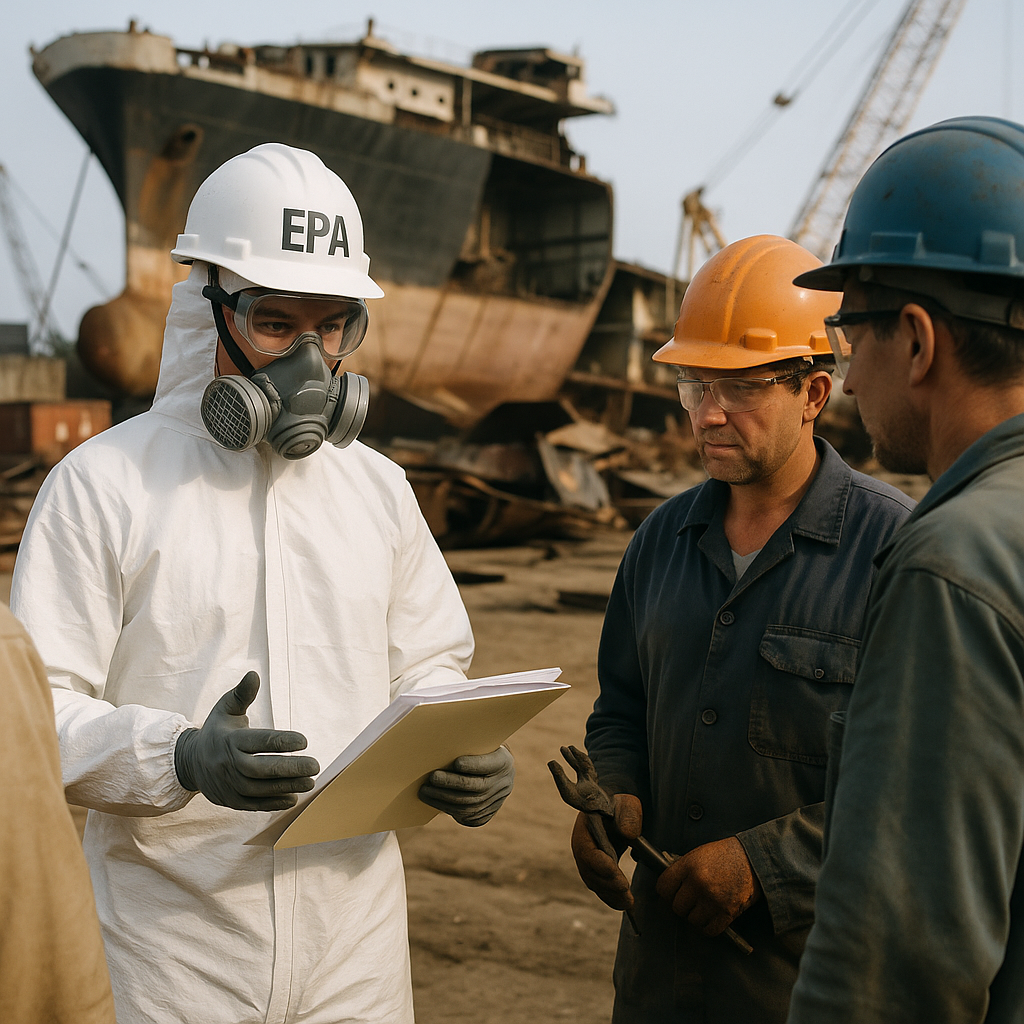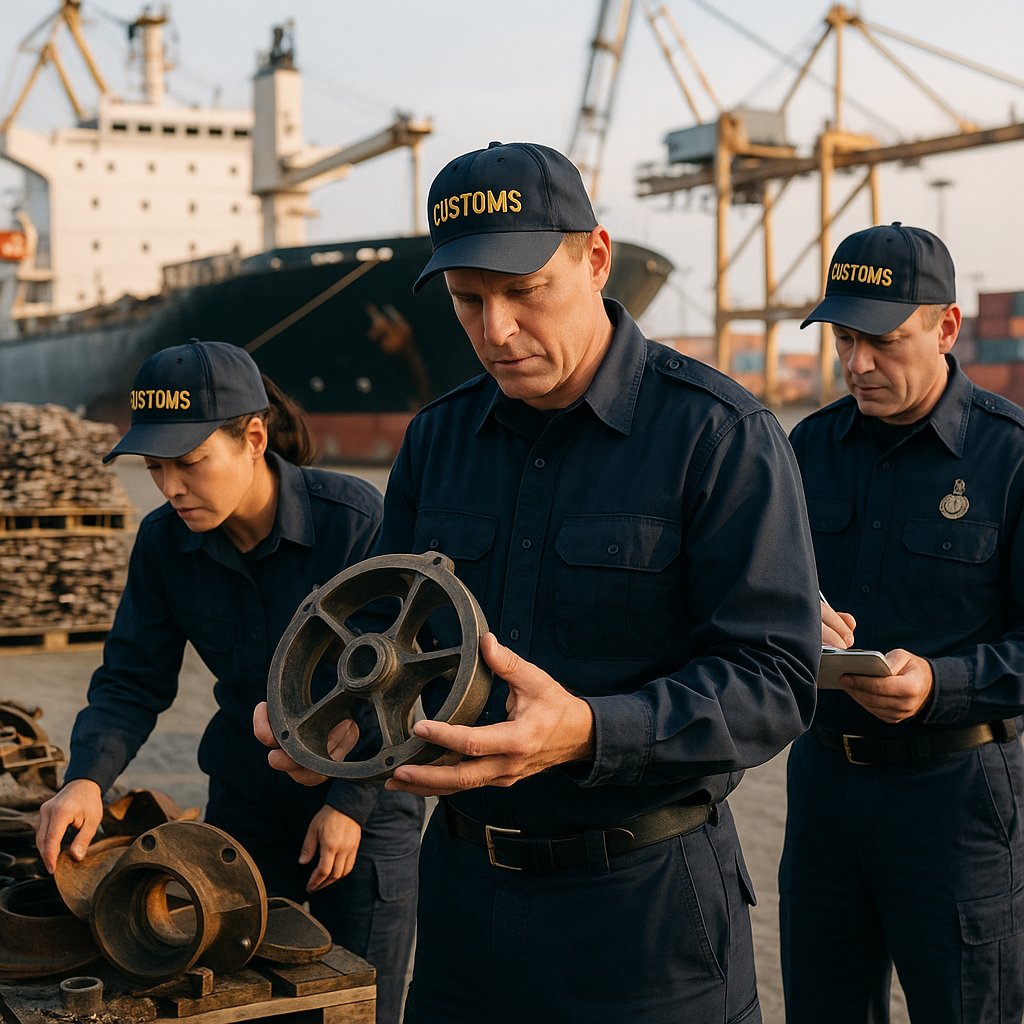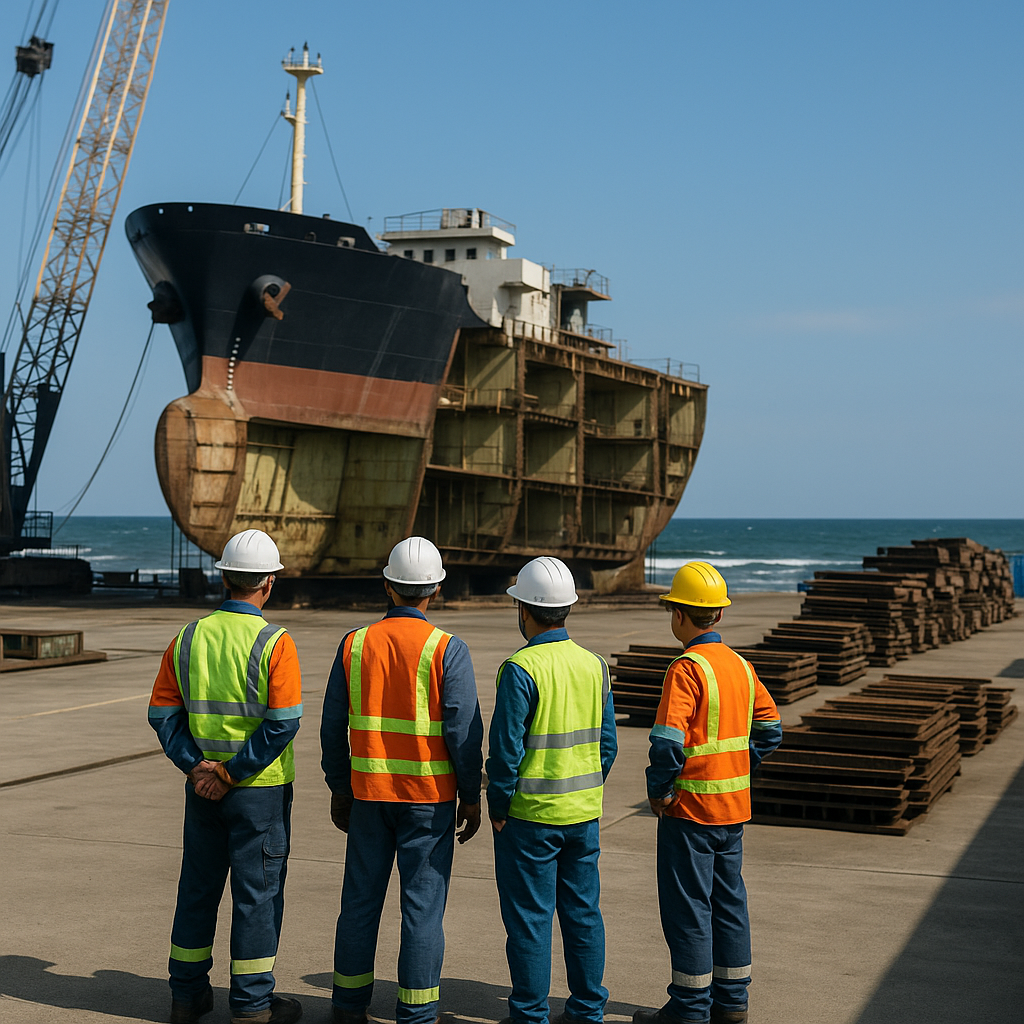5901 Botham Jean Blvd, Dallas, TX 75215
What Are the Key Environmental Regulations for Shipbreaking in the US?
July 31, 2025Shipbreaking operations in the United States are governed by stringent environmental regulations aimed at protecting human health and the environment. These regulations address the complex challenges posed by end-of-life vessels, which often contain hazardous materials requiring proper handling and disposal.
The shipbreaking industry must comply with four primary federal environmental laws that form the regulatory backbone of this sector:
- Toxic Substances Control Act (TSCA): Regulates PCBs and other toxic chemicals commonly found in older vessels. Section 6(e) specifically restricts the manufacture, processing, distribution, and disposal of PCBs above 50 parts per million without an EPA exemption.
- National Environmental Policy Act (NEPA): Requires federal agencies to assess environmental impacts before undertaking major actions like ship disposal. Agencies must prepare Environmental Assessments (EAs) and, if significant impacts are identified, comprehensive Environmental Impact Statements (EIS).
- Resource Conservation and Recovery Act (RCRA): Provides a “cradle-to-grave” framework for managing hazardous waste throughout the shipbreaking process. It establishes standards for waste identification, transportation, storage, treatment, and disposal.
- National Maritime Heritage Act (NMHA): Directs the Secretary of Transportation to dispose of vessels in a manner that provides the best value to the Government while considering environmental impacts, particularly when towing vessels poses serious environmental threats.
These regulations aim to minimize environmental damage while ensuring safe and responsible dismantling practices. For shipbreaking facilities, compliance requires careful planning, proper infrastructure, and thorough knowledge of hazardous material management techniques.
How does the EPA guide shipbreaking facilities on environmental compliance?

The Environmental Protection Agency (EPA) offers comprehensive guidance for shipbreaking facilities through its publication A Guide for Ship Scrappers: Tips for Regulatory Compliance. This resource outlines the environmental and worker safety requirements involved in ship recycling operations.
The guide explains key processes specific to shipbreaking operations, detailing the applicable regulations for each step. Following these guidelines enables facilities to reduce environmental impacts and ensure the protection of workers handling hazardous materials.
Key Components of the EPA Guide
The EPA guide breaks down the shipbreaking process into distinct operational activities, each with specific compliance requirements. For every major shipbreaking activity, the guide outlines potential hazards, regulatory obligations, and best practices for environmental protection.
- Asbestos Removal: The guide details proper containment, removal techniques, and disposal methods for asbestos-containing materials found in older vessels, especially in thermal insulation for pipes and bulkheads.
- PCB Management: Instructions for identifying, handling, and disposing of polychlorinated biphenyls found in electrical equipment, paints, and other ship components.
- Fuel and Oil Removal: Procedures for safely extracting and containing petroleum products to prevent spills and contamination of water bodies.
- Metal Cutting Operations: Guidelines for minimizing air emissions and managing waste from cutting activities, including proper handling of contaminated materials.
- Bilge and Ballast Water Management: Requirements for testing, treating, and disposing of potentially contaminated water that may contain toxic substances.
Coordinated Compliance Approach
The EPA doesn’t work alone. A formal Memorandum of Understanding exists between the EPA, the Occupational Safety and Health Administration (OSHA), the Department of the Navy, and the Maritime Administration. This agreement establishes procedures for:
Joint coordinated inspections of shipbreaking operations to provide a comprehensive approach to environmental and occupational safety compliance. The EPA commits to conducting at least one compliance inspection annually at qualified ship recycling facilities, ensuring ongoing adherence to environmental standards.
Practical Implementation Tools
Beyond explaining regulations, the EPA guide provides practical tools to help facilities implement compliant practices:
- Process-Specific Checklists: Step-by-step verification tools for different shipbreaking activities.
- Regulatory References: Direct citations to relevant Code of Federal Regulations requirements.
- Environmental Management Guidance: Recommendations for developing systems to track compliance and prevent violations.
The guide emphasizes the importance of proper hazardous waste management, highlighting that shipbreaking facilities must develop comprehensive plans for identifying, removing, and disposing of toxic materials before dismantling begins.
Environmental Standards and Monitoring
EPA guidelines establish clear standards for environmental protection during shipbreaking operations. These include:
Containment requirements to prevent the release of hazardous substances into soil and water. Facilities must implement appropriate controls to manage runoff, particularly when operations occur near waterways. The guidelines also outline air quality monitoring procedures to ensure emissions from cutting and other activities remain within acceptable limits.
For facilities seeking to improve their environmental performance beyond minimum compliance, the guide offers additional recommendations for adopting more sustainable practices in ship recycling operations.
No table output available
Through this comprehensive approach to regulatory guidance, the EPA ensures that shipbreaking operations protect both human health and the environment while facilitating the recycling of valuable materials from end-of-life vessels.
What challenges does the US face in regulating shipbreaking exports?

The United States faces complex regulatory dilemmas in managing shipbreaking exports. Balancing domestic environmental protection with economic realities is a persistent challenge. Aging ships in the National Defense Reserve Fleet contain hazardous materials like PCBs, asbestos, heavy metals, and oils posing environmental risks, whether in US waters or abroad.
Legal hurdles present significant obstacles for ship export programs. The Maritime Administration (MARAD) must navigate domestic regulations, including the Toxic Substances Control Act (TSCA), which restricts PCB exports, and the National Environmental Policy Act (NEPA), which requires environmental impact assessments. The Resource Conservation and Recovery Act (RCRA) adds complexity with its hazardous waste management regulations.
Enforcement challenges arise when ships cross international boundaries. How can the US ensure environmental and worker safety standards in foreign shipyards? This question became central in 2003 when MARAD awarded a contract to UK-based Able UK to dismantle ships from the James River Reserve Fleet. Despite oversight promises, investigations revealed the foreign facility lacked proper permits and infrastructure.
International obligations and legal uncertainties
The US faces questions regarding its international obligations. Though not a party to the Basel Convention, which regulates transboundary movements of hazardous waste, the US is a signatory. This creates uncertain legal territory—while not bound by the Convention’s terms, the US maintains a moral obligation not to undermine its objectives.
The 2003 lawsuit Basel Action Network v. Maritime Administration highlighted these tensions. Environmental groups challenged MARAD’s pilot program to export ships to the UK, claiming violations of environmental laws. The court initially required a more thorough environmental assessment, showing how citizen enforcement can impact regulatory decisions.
Cost considerations add pressure to the regulatory landscape. Domestic shipbreaking operations face high environmental compliance costs, making foreign options financially attractive. However, this economic calculation ignores potential environmental disasters during transit or remediation costs if exported ships contaminate foreign environments.
Balancing oversight with feasibility
US regulators struggle to determine appropriate oversight levels for exported vessels. Should they ensure PCBs and other hazardous materials are removed before export, or should they monitor the entire dismantling process in foreign yards? Complete pre-export remediation is safest but costly. Limited monitoring is more feasible but poses environmental risks.
The challenge also involves coordination between agencies. The EPA and MARAD sometimes operate with different priorities—environmental protection versus fleet reduction. This has led to situations where ships received export approval despite environmental concerns, as seen in the “enforcement discretion” approach where the EPA chose not to enforce certain PCB export restrictions.
A practical question also emerges: How can the US track hazardous materials once ships leave its waters? Without robust international agreements and monitoring mechanisms, ensuring proper waste management becomes nearly impossible. This challenge is compounded by different environmental standards across recipient countries.
These challenges highlight the need for comprehensive solutions that protect environmental interests while recognizing economic realities. Cases like Basel Action Network v. MARAD indicate that while export programs may proceed, they will face increasing scrutiny and higher environmental standards.
| Challenge | Description |
|---|---|
| TSCA | Restricts PCB exports and requires compliance for exporting ships containing hazardous materials. |
| NEPA | Involves conducting environmental impact assessments for major actions like ship exportation. |
| RCRA | Provides a framework for managing hazardous waste during shipbreaking. |
| EPA Compliance | Ensures facilities meet environmental and safety regulations through guidelines and inspections. |
| International Agreements | Influence US regulations, with treaties like Basel and Stockholm Convention affecting policy. |
| Legal and Economic Pressures | High compliance costs domestically versus potential environmental risks with exporting. |
| Coordination Challenges | Ensuring agencies like EPA and MARAD align goals and practices for environmental and fleet management. |
How do international agreements impact US shipbreaking regulations?

International agreements significantly influence U.S. shipbreaking regulations, even though the United States hasn’t ratified some important treaties. These global frameworks establish standards that shape domestic policies and industry practices.
The Basel Convention, adopted in 1992, is a key international agreement affecting shipbreaking. It aims to control the movement of hazardous wastes across borders, particularly from developed to developing nations. While the U.S. is a signatory, it hasn’t ratified the Convention. Nonetheless, the Basel Convention’s requirements impact U.S. ship disposal decisions, as trading partners and destination countries must comply with its provisions.
The Stockholm Convention on Persistent Organic Pollutants obliges ratifying parties to prevent foreign contamination by toxic substances. It limits the import and export of PCBs unless they are disposed of in an environmentally sound manner. Although the U.S. is only a signatory and not a party to this convention, it enjoys bipartisan support in Congress.
The International Maritime Organization (IMO) has developed guidelines that influence the ship disposal process. In 2003, the IMO introduced guidelines to improve shipbreaking practices globally. These guidelines advocate for a “Green Passport” approach, encouraging the use of non-hazardous materials and requiring ship owners to maintain inventories of hazardous wastes.
The U.S. shipping industry must consider these international frameworks when disposing of vessels. For instance, when the Maritime Administration (MARAD) awards contracts for ship disposal, it must evaluate the environmental standards of destination countries. If a foreign shipyard doesn’t meet certain international standards, MARAD could face criticism and legal challenges, as seen in past cases where environmental groups took legal action to prevent exports.
International Shipbreaking LLC in Brownsville, Texas, exemplifies success in meeting global standards. It’s the only U.S. recycling yard approved by the EU Commission to dismantle large vessels flying EU member state flags. This approval required compliance with the EU Ship Recycling Regulation, illustrating how international standards can drive improvements in domestic facilities.
Although not legally binding on the U.S., these international agreements set a framework of expected behavior. They establish moral obligations for the U.S. as a signatory, even without formal ratification. U.S. agencies like the EPA often reference international standards when developing domestic regulations, indirectly influencing U.S. shipbreaking practices.
Complex legal frameworks
The relationship between U.S. domestic law and international agreements creates a complex regulatory landscape. The U.S. EPA typically doesn’t consider environmental impacts in other countries when making regulatory decisions, focusing on health and environmental protection within U.S. borders. Court cases have supported this stance, with the Supreme Court ruling that U.S. legislation generally applies only within the nation’s jurisdiction.
Despite this domestic focus, there’s growing recognition that the U.S. should consider the foreign effects of its ship disposal decisions. The pilot program requirement that export plans “appropriately address” foreign environmental and worker health concerns suggests Congress intends for ship owners to think about the global impacts of scrapping decisions.
As awareness of hazardous waste management increases, U.S. regulations are evolving in response to international pressure and standards. While the U.S. maintains its sovereignty in regulatory decisions, there is a trend toward greater alignment with global frameworks for environmentally sound ship recycling.
This balance between domestic priorities and international obligations continues to shape the future of U.S. shipbreaking regulations.
| Basel Convention | Regulates transboundary movements of hazardous wastes; significant in shipbreaking due to hazardous materials on ships. |
| Stockholm Convention | Addresses pollutants like PCBs; not fully ratified by the U.S. but influences domestic implementation around imports/exports of hazardous materials. |
| Hong Kong Convention | Aims to ensure ships are recycled safely and environmentally; adopted in 2009 but not yet universally in force. |
| IMO Guidelines | Voluntary guidelines advocating for best practices in ship recycling, including the ‘Green Passport’ for hazardous waste inventories. |
Conclusion: The future of environmental regulations for shipbreaking in the US

As the shipping industry evolves, US environmental regulations for shipbreaking are likely to strengthen in response to growing environmental concerns and international pressure. Balancing environmental protection, worker safety, and economic viability remains a key challenge in policy development. The implementation of the Hong Kong Convention in June 2025 marks a significant milestone, establishing minimum global standards for safe, environmentally sound ship recycling.
The United States faces unique challenges in developing its domestic shipbreaking capacity while engaging with international recycling markets. The success of facilities like International Shipbreaking in Brownsville, Texas—the only US yard approved under EU standards—demonstrates that environmentally responsible practices can be economically viable with proper investment and regulatory support. As regulations evolve, more US facilities may adopt higher standards to compete globally.
In the future, increased international cooperation and adoption of best practices will likely shape US regulatory approaches. The ongoing tension between domestic recycling and export options will continue to influence policy debates, with environmental groups advocating for stricter oversight of exports, while industry stakeholders support practical, cost-effective solutions. For comprehensive recycling solutions for your business’s metal waste needs, contact Okon Recycling at 214-717-4083.
